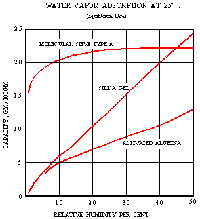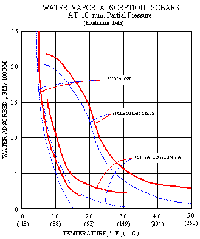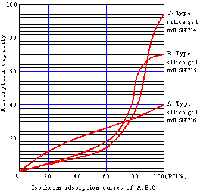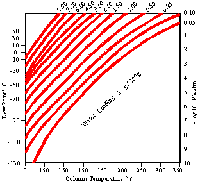|
|
|
|
| |

|
 |
|
| |
|
|
 |
| |
MOLECULAR
SIEVE |
| |
Adsorption
on Molecular Sieve is characterized
by a Langmuir-type isotherm, where the
amount of a given compound adsorbed
increases rapidly to a saturation value
as its pressure or concentration increases
in the external bulk phase. Any further
increase in pressure at constant temperature
causes no further increase in the amount
adsorbed. With Molecular Sieves this
equilibrium saturation value usually
corresponds to a complete filling of
the internal void volume with the adsorbate. |
| |
|
| |
Molecular
Sieve retain adsorbates by strong
physical forces rather than by
chemisorption. This means that
when the adsorbed molecule is
desorbed by the application of
heat or by displacement with another
material, it leaves the crystal
in the same chemical state as
when it entered.
The external surface area of the
Molecular Sieve crystal is available
for adsorption of molecules of
all sizes, whereas, the internal
area is available only to molecules
small enough to enter the pores.
The external area is only about
1 per cent of the total surface
area. Materials which are too
large to be adsorbed internally
will commonly be adsorbed externally
to the extent of 0.2 to 1 weight
per cent. |
 |
|
| |
|
| |
| ADSORPTION
DIRECTION |
| Drying
Streams to Very Low Water
Contents |
| Drying
by adsorption is used in
industry because molecular
sieve typically produces
a drier liquid or gas than
can be obtained by other
commercial methods. However,
not all adsorbents can dry
liquids to the same degree.
Molecular sieve is outstanding
in their ability to produce
low effluent water concentration.
They are the ideal adsorbent
to use wherever extremely
dry streams are required.
Water concentrations as
low as 35 parts per billion
are obtainable in dynamic
drying service over a wide
range of operating conditions. |
| |
| Drying
and Purifying Streams In
One Step |
By
selection of the molecular
sieve type and the proper
operating conditions, it
is possible to remove other
impurities from the stream
along with water. As has
already been pointed out,
molecular sieve adsorb water
more strongly than any other
material. As a result, the
adsorbed water concentrates
initially at the inlet end
of the bed where it displaces
the other impurities that
have been previously adsorbed.
These desorbed impurities
are then re-adsorbed farther
down the column.
As displacement continues,
the desorbed impurities
will begin to appear in
the effluent stream. In
normal drying operations
this displacement is allowed
to continue until little
adsorbate, other than water,
is left on the bed. However,
molecular sieve is possible
to design and operate a
molecular sieve adsorption
system in such a manner
that the other impurities
are retained on the adsorbent,
instead of allowing them
to re-enter the purified
stream. molecular sieve
is necessary, of course,
to provide sufficient bed
to contain the impurities
in addition to the water.
Isotherms showing equilibrium
loading for some of the
more common impurities encountered
in purification processes
are shown in above figures.
|
| |
| Drying
Without Altering Stream
Composition |
| In
some drying operations molecular
sieve is not unusual to
find that other components
of the feed are adsorbed
in addition to water. Where
product composition is critical,
as is the case with many
chemical process stream,
co-adsorption presents a
serious problem. In fact,
in some instances adsorption
has been ruled out completely
and another method of drying
adopted because molecular
sieve was impossible or
impartial to control co-adsorption.
This need not be the case
if molecular sieve is used.
The
co-adsorption problem
can be solved easily by
selecting a molecular
sieve type with a critical
pore diameter small enough
to prevent all stream
components except water
from being admitted to
the active inner surfaces
of the adsorption cavities.
This prevents the co-adsorption
of materials other than
water - including polar
and unsaturated components-while
providing maximum capacity
for water and effluent
water concentrations of
one to ten parts per million.
Another
factor bearing on the
elimination of co-adsorption
is the extremely high
adsorptive attraction
for water possessed by
molecular sieve. This
affinity is so strong
that water will normally
displace any other material
that is already adsorbed
on them. Also, molecular
sieve is possible to enhance
this normal selectivity
by raising the temperature
of the bed. The rate of
adsorption will be somewhat
reduced if the water has
to displace another material
before molecular sieve
can be adsorbed. Despite
this, molecular sieve
still offer a great improvement
in performance over other
adsorption systems.
|
| |
| Drying
Streams at High Temperature |
| Molecular
sieve is the only adsorbents
that can dry streams effectively
at high temperatures. The
isobars plotted in the accompanying
graph illustrate this type
of performance. At 200oF
(93oC) and above, they have
better than 13 weight percent
capacity. Even at 400oF
(204oC.), they still have
a capacity of 3 weight percent.
By comparison, the equilibrium
capacity of alumina and
silica gel type desiccants
decreases rapidly as soon
as the temperature rises
above 75 or 80oF (25oC).
At 300oF (149oC.), both
of these desiccants have
lost their capacity for
water, while molecular sieve
still have the ability to
adsorb some water at temperatures
over 600oF (316oC.) |
 |
The
isobars which appear
as solid lines assume
the use of completely
regenerated adsorbents.
The capacity is lowered
by any residual water
left on the adsorbent;
this factor is especially
important in high
temperature drying.
The effect of 2 percent
residual water at
the start of adsorption
is shown by the dotted
line isobars. In some
applications, this
amount of water can
completely consume
the adsorption whereas
this or even greater
amounts of residual
water have relatively
little effect on the
capacity of molecular
sieve. |
|
|
|
| |
|
| |
|
| |
| STRUCTURE
ANALASIS |
| Formula |
| Na86
[ ( AIO2)
86 (Si92) 106 ] H2O. |
| |
| Description |
| White
ball or cylinder type, high
specific surface area, generally
used as an adsorbent.
|
| |
| Preparation |
| Mixed
raw material according
the mole ration: |
|
Al2O3
|
:
10% |
|
SiO2
|
:
36.60% |
|
NaOH
|
:
48.10% |
|
H2O
|
:
1.80% |
|
| Mixture
stirred under 102
+/- 2oC, Crystallized
and shaped, activated. |
|
| |
| Uses |
| For
general gas drying, air
plant feed purification
(simultaneous removal of
H2O
and CO2)
and liquid hydrocarbon and
natural gas sweetening (H2S
and merchantman removal). |
|
|
| |
|
| |
|
| |
| 13X
MOLECULAR SIEVE |
| Description
|
| Molsiv
adsorbent type 13X, the
sodium form of the type
X crystal structure, is
an alkali metal alumino-silicate.
Type 13X will adsorb molecules
with critical diameters
up to 10 angstroms. |
| |
| Applications |
Type
13X is used commercially
for general gas drying,
air plant feed purification
(simultancous removal of
H2O and CO2) and liquid
hydrocarbon and natural
gas sweetening (H2S and
mercaptan removal).
All molecules which can
be adsorbed on Molecular
Sieve type 3A, 4A, and 5A
can be sdsorbed on type
13X. In addition, type 13X
can adsorb molecuies of
larger criticai diameters,
such as aromatics and branched-chain
hydrocarbons. |
| |
| Chemical
Formula |
| Na36
[(AlO2)
wxy (SiO2)
wxy] X H2O |
| |
| Regeneration |
| Molsiv
adsorbent type 13X
can be regenerated
for re-use by purging
or evacuating at elevated
temperatures. The
degree of regeneration
(water removal) is
dependent on the temperature
and humidity of the
purge gas. |
|
Type
Properties
|
1/16"
Pellets
|
1/8"
Pellets
|
Powder
|
8x12
Beads
|
4x8
Beads
|
|
Nominal
Pore Diameter
|
10
Angstroms
|
10
Angstroms
|
10
Angstroms
|
10
Angstroms
|
10
Angstroms
|
|
Bulk
Density
|
38
lbs/cu ft
|
38
lbs/cu ft
|
-
- -
|
40
lbs/cu ft
|
40
lbs/cu ft
|
|
Hydrated
Wet Density
|
-
- -
|
-
- -
|
1.95
g/cc
|
-
- -
|
-
- -
|
|
Activated
Dry Density
|
-
- -
|
-
- -
|
1.53
g/cc
|
-
- -
|
-
- -
|
|
Particle
Diameter
|
0.0575
in.
to 0.0775
in.
|
0.115
in.
to 0.135 in.
|
<
10 microns*
|
100%thru-8
<5%thru-12
|
100%thru-4
<5%thru-8
|
|
Crush
Strength
|
7
lbs
|
14
lbs
|
-
- -
|
4
|
15
|
|
Crystal
Structure
|
-
- -
|
-
- -
|
Cubic
|
-
- -
|
-
- -
|
|
|
| |
|
Type
Properties
|
1/16"
Pellets
|
1/8"
Pellets
|
Powder
|
8x12
Beads
|
4x8
Beads
|
|
Heat
of Adsorption
(max)
|
1800
btu/lb H2O
|
1800
btu/lb H2O
|
1800
btu/lb H2O
|
1800
btu/lb H2O
|
1800
btu/lb H2O
|
|
Equilibrium
H2O
Capacity**
|
24%
wt
|
24%
wt
|
24%
wt
|
24%
wt
|
24%
wt
|
|
Water
Content
(as shipped)
|
<
1.5% wt
|
<
1.5% wt
|
<
1.5% wt
|
<
1.5% wt
|
<
1.5% wt
|
|
Molecules
Adsorbed
|
Molecules
with an effective
diameter <10
angstroms.
|
|
Molecules
Excluded
|
Molecules
with an effective
diameter >10
angstroms.
E.g., (C4F9)N
|
|
| * |
Agglomerate
panicle size.
Average crystal
size is 1.0
to 4.5 microns. |
| ** |
Lbs
H2O/100 lbs
activated adsorbent
at 17.5 mm Hg
25oC. |
|
|
|
|
| |
|
| |
|
| |
| 13X
MOLECULAR SIEVE TECHNICAL DATA
SHEET |
| Nominal
Pore Size |
- - - - - -
- - - - - -
- - - - - -
- - - - |
10
Angstoms |
|
| Type
of Crystal Structure |
- - - - - -
- - - - - -
- - |
Body
Center Cubic |
|
| Equilibrium
Water Capacity
@ 25°C |
- - - - |
@
10% RH 19%
@ 50% RH 22% |
|
| Bulk
Density |
- - - - - -
- - - - - -
- - - - - -
- - - - - -
- - - |
40.6
/ 0.5 |
|
| Crush
Strength |
- - - - - -
- - - - - -
- - - - - -
- - - - - -
- |
7.7
lbs |
|
| Heat
of Adsorption
(max.) |
- - - - - -
- - - - - -
- |
1800
BTU / 16 H2O |
|
| PH
(Slurry) |
- - - - - -
- - - - - -
- - - - - -
- - - - - -
- - - - - |
11
/ 1 |
|
| Loss
on Ignition |
- - - - - -
- - - - - -
- - - - - -
- - - - - - |
2.5%
Max. |
|
|
| |
| Applications: |
| Type
13X is used commercially
for general gas drying,
air plant feed purification
(simultaneous removal of
H2O and CO2) and liquid
hydrocarbon and natural
gas sweetening (H2S and
mercapstan removal). All
molecules which can be adsorbed
on molecular sieves 3A,
4A and 5A can be adsorbed
on type 13X. In addition,
type 13X can adsorb molecules
of larger critical diameters,
such as aromatics and branches-chain
hydrocarbons |
| |
|
|
|
|
|
| |
 |
 |
| |
SILICA
GEL DESICCANT GRADE PRODUCT DETILS AND
SPECIFICATIONS |
| |
Non-Indicating
(White) Type: This has high absorption
efficiency. It absorbs water and all
condensable vapors whose boiling point
is above 10℃. It does not contain any
indicator so it is not easy to ascertain
whether it has completely moisturized.
The above product is free from foreign
impurities such as Chlorides, Sulphates
and organic matter and have high absorption
efficiency.
Absorption efficiency increases under
higher humidity, higher pressure and
lower temperature. It can be regenerated
by first keeping in sun light or heating
to a temperature of 150℃. The product
should not be heated to temperatures
above
250℃ as at this stage Silica Gel loses
all of it's water content, leading to
a complete loss of all the properties
of absorption. |
| |
|
| |
SN0316
SPECIFICATIONS |
| |
Absorption
efficiency: Above 25% under 50% R.H.
and 20℃ temperature: Above 65% under
100% R.H. and 20℃ temperature.
Combined
Water: Maximum 6% (Loss or drying at
150℃).
Chloride (as NaCl): Less than 0.05%. |
| |
|
| |
SN0316
SPECIFICATIONS |
| |
Sulphate
(as Na2 So4): Less than 0.25%
Organic Matter (as NH3): Less than 0.001%.
PH: Between 6 to 8.
Cobalt Chloride: 1 to 1.5% (in Indicating
type Blue).
Friability and dust: Less than 0.05%.
Average purity: 99.80 or more % Silica
(SiO2) or dry basis. |
| |
|
| |
PHYSICAL
CONSTRAINTS |
| |
Pore
Volume: 1.2 to 1.3 cc/gm
Pore Diameter: Average 140 to 150 Angstrom
Units.
Surface Area: 500 to 700 square meters
per gm.
Average Porosity: 60 to 65%
Thermal Conductivity: 1 BTU/sq ft /
hr / F / in.
Sp Heat: 0.2 to 0.22 BTU / lb / F
Specific Gravity: 2.10 to 2.30
Hardness: 5 on Moh Mineralogical Scale.
Oil absorption: 1.6 g/g
Percentage of Fe / other impurities:
Nil.
Capacity to absorb: Moisture from air,
any condensable vapours, oil. Acetylene
and other hydrocarbons from liquid oxygen.
Re-activation temperature: 150℃ |
| |
|
| |
THE
CHARACTERISTICS AND SAFETY PERFOMANCE |
| |
Silica
Gel is a kind of highly active adsorption
material. It is usually formulated by
sodium silicate and sulphuric acid reaction
and through a series of after treatment
processes such as aging, pickling, etc.
Silica Gel is amorphous substance. Its
chemical molecular formula is SiO2,
nH2O. It is insoluble in water and any
other solvent. It is nontoxic, nonodor
and chemically stable. Except ofr alkali
and hydrofluoric acid, it does not react
with any other substance. Owing to their
different manufacturing methods, the
various types of silica gels are formulated
with different pore structures. Thanks
to its unique chemical composition and
physical structure. Silica Gel possesses
a number of characteristics with which
other similar materials are incomparable,
such as high adsorption feature, stable
thermal performance, stable physical
property and relatively high mechanical
strength etc.
According
to the different pore diameters of
Silica Gel, they are categorized into
large pore Silica Gel, macro-pored
Silica Gel, B type Silica Gel and
fine-pore Silica Gel. Owing to their
different pore structures, their adsorptive
performances are variable. Under the
circumstance where there is a high
relative humidity, macro-pored Silica
Gel (c type) has a relatively high
adsorption capacity. Whereas, under
the circumstance where there is a
low relative humidity, Ting-pored
Silica Gel (A type) has a higher adsorption
capacity than macro-pored and fine-pored
Silica Gel. The pore structure of
Silica Gel type B lies between macro-pored
and fine-pored Silica Gel, so its
adsorption amount is also between
those of macro-pored and fine-pored
Silica Gel. Large pored Silica Gel
is usually used as catalyst carrier,
matting agent and toothpaste abrasive,
etc. Therefore, the appropriate type
is to be selected according to your
specific field of application.
|
| |
 |
| |
|
| |
|
| |

|
| |
|
| |
ACTIVATED
ALUMINA PRODUCT DETILS AND SPECIFICATIONS |
| |
TECHNICAL
DATA: F-200 |
| |
Activated
Alumina is an aluminum oxide which is
highly porous and exhibits tremendous
surface area. Activated Alumina is resistant
to thermal shock and abrasion and will
not shrink, swell, soften nor disintegrate
when immersed in water.
Masda
features F-200 Activated Alumina.
F-200 is known for its uniform ball
size, high crush strength, low abrasion,
high pressure drop and adsorption
capacity.
|
| |
|
| |
PARTICLE
SHAPE AND SIZE |
| |
F-200
is available in very smooth, uniform
balls of 1/8" (3.2 mm), 3/16"
(4.8 mm) or 1/4" (6.4 mm). The
uniformity of ball size prevents channeling
of the gas flow and minimizes pressure
drop. |
| |
|
| |
PRODUCT
APPLICATIONS |
| |
Drying
- Nearly all gases and liquids can be
dried with F-200. Due to the high surface
area (350 sq. meters / gram), F-200
is an effective adsorbent in such gases
as Acetylene, Oxygen, Methane and Oxygen
along with fluids such as Benzene, Freon,
Hydraulic Oils, Kerosene, transformer
and vegetable oils. |
| |
|
| |
Acid
Removal - Transformer oils, lubricating
oils and refrigerants all form degradation
acids upon use. F-200 Activated Alumina
will remove these corrosive acids thus
protecting valuable equipment. |
| |
|
| |
PHYSICAL
PROTOTIES |
| |
Size:
O 3-5 mm, O 4-6 mm, O 5-7 mm, O 3 X
3-8 mm small ball with grain size of
30-200 mesh.
A
white or slight-red particle, ball-shaped
or roll-shaped, insoluble in water
and organic solvent, soluble in strong
acids and alkalis, odourless, tasteless,
non-toxic. After adsorbing moisture
in air, it does not expand and crack,
and keeps its original shape. It is
adsorptive with Nox, F2, as and other
gases. Widely used as catalyst for
recovering sulfur in petrochemical
industry, excellent defluorinating
agent for drinking water, defluorinating
agent for recycling alkyl-hydrocarbon
in alky benzene production, reclaiming
agent for deacidic in transformer
oil, dearsenic agent in acid industry,
adsorbent in the production of hydrogen
peroxide solution, catalyst for polyhydro-ammonia
by substituting Silica Gel with ball-shaped
product, desiccator and purifying
agent for different kinds of gases
and liquids. In recent years, we have
developed two types of new products
- LS811 and LS-931 according to the
market requirement. With reasonable
structure and higher application performance,
the products are mainly used as catalyst
for oil production and Klaus sulfur
recycling equipment full of acidic
gas, featuring high transfer efficiency,
ling life, good effect of desulphuration
for waste gas, and good performance
for anti-sulfate toxic.
|
| |
 |
| |
|
| |
TECHNICAL
DATA SHEET SPHERES F-200 |
| |
| TYPICAL
PROPERTIES |
|
CHEMICAL
|
Al203
|
- - - - - - - - - - -
- - - - - - - - - - -
- - - - - - - - - - -
-
|
93.01% |
|
|
Sio2
|
- - - - - - - - - - -
- - - - - - - - - - -
- - - - - - - - - - -
-
|
02% |
|
|
Fe2O3
|
- - - - - - - - - - -
- - - - - - - - - - -
- - - - - - - - - - -
-
|
02% |
|
|
Na2O
|
- - - - - - - - - - -
- - - - - - - - - - -
- - - - - - - - - - -
-
|
30% |
|
|
LOI
|
- - - - - - - - - - -
- - - - - - - - - - -
- - - - - - - - - - -
-
|
6.50% |
|
| |
| PHYSICAL |
|
TOTAL
PORE VOLUME
|
- - - - - - - - - - -
- - - - - - - - - - -
- - - - - - - - -
|
0.5
cc/gram |
|
| |
| SURFACE |
| AREA |
- - - - - - - - -
- - - - - - - - -
- - - - - - - - -
- - - - - - - - -
- - - - - - - - |
350
m2 / gram |
|
| STATIC
ADSORPTION |
@
60% RH- - - - - - - - -
- - - - - - - - - - - -
- - - |
22% |
| @
100% RH- - - - - - - - -
- - - - - - - - - - - -
- - |
43% |
| ABRASION
LOSS |
- - - - - - - - -
- - - - - - - - -
- - - - - - - - -
- - - - - - - - -
- - - - - - |
0.1% |
|
| BULK
DENSITY |
- - - - - - - - -
- - - - - - - - -
- - - - - - - - -
- |
48
lbs / ft3 / 0.77g
/ cc |
|
|
| |
| APPLICATIONS |
| Desiccant
in air, gas and refrigerant drying.
F-200 is physically strong and
resistant to attrition and abrasion.
It is suitable for pneumatic handling.
It exhibits high density and adsorptive
capacity, thereby providing high
volumetric capacity. |
| |
|
| |
TYPICAL
PROPERTIES |
| |
CHEMICAL
COMPOSITION |
| |
| SiO2 |
<
= 0.06 |
| Fe2O3% |
<
= 0.03 |
| Na2O% |
<
= 0.50 |
| BET-surface |
300
+ -20 m2/g |
| Pore-volume |
0.4
+ -0.02 ml/g |
| Moisture
adsorption |
>
= 50 |
| Static
water-adsorption |
>
20.0% |
| Specific
wear ability |
<
0.05% |
| Bulk
density |
0.7
+ -0.02 kg/L |
| Crushing
strength |
Min.
120 N |
|
| |
|
| |
|
|
| |
| |
|
|
|
|
|